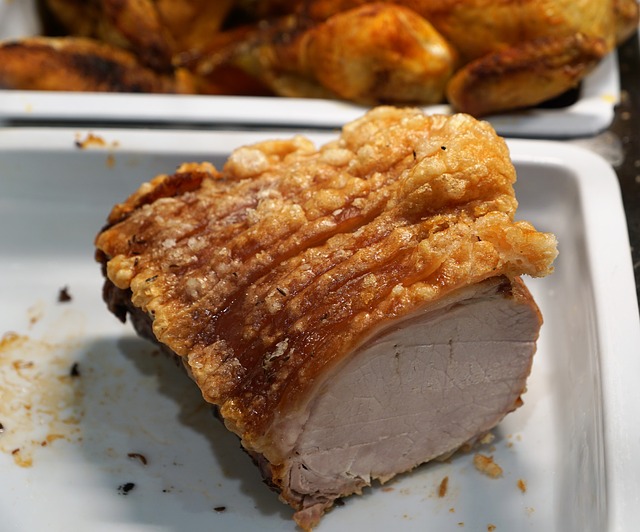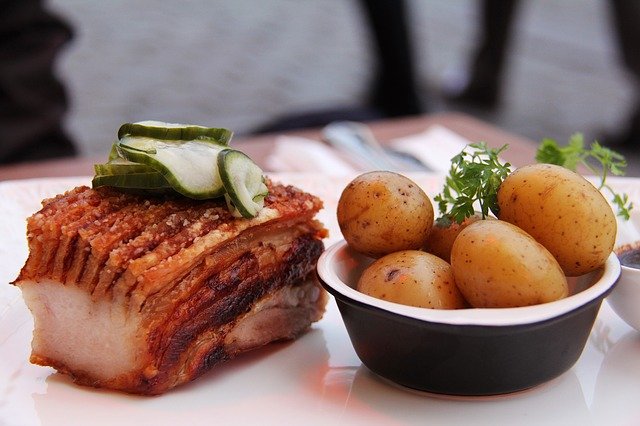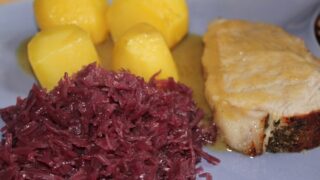“Flæskesteg” is one of the most commonly eaten meat dishes in Danish households, where pork consumption is high.
It is a Danish roast pork dish made by roasting chunks of pork belly in the oven.
In this article, I will introduce the characteristics of “Flæskesteg,” its recipe, and how it is typically enjoyed in local Danish cuisine.
What is Flæskesteg?
Roast pork, dripping with meat juice, is a popular meat dish not only in Japan but also in Denmark.
In Denmark, roast pork is called “Flæskesteg,” which is Danish for “roast pork.”
Danish Flæskesteg is characterized by a crispy crust that is slow-cooked in the oven.
The surface skin is crispy, while the interior is tender and juicy. It is often enjoyed with beer as well.
Dishes that can be eaten for everyday dinners and even at Christmas

Danes have a custom of eating a light breakfast and lunch with a sandwich, and a hot meal for dinner.
Since many households have two working parents, oven cooking is preferred because it can be done in a short period of time.
Therefore, many Danish households have built-in ovens.
Flæskesteg is a staple dish served at many dinner tables in Denmark.
It is also a popular dish, especially on Christmas night, similar to turkey in Japan.
It is worth noting that high-calorie pork dishes have long been popular in Denmark due to its cold climate.
The Danish people consume more pork than any other people in the world, and the rich repertoire of pork dishes, including Flæskesteg, which is introduced in this article, is a characteristic of Danish cuisine.
Recipe for Flæskesteg
As Flæskesteg has become a go-to dish for Danes who want to cook quickly, its recipe is also simple.
The main ingredients are a block of pork belly, seasonings of salt and pepper, and herbs such as cloves and bay leaves to remove the smell of the meat.
In Denmark, pork belly with skin is typically used.
However, in Japan, it is often difficult to obtain pork with skin, so fatty pork belly can be used instead.
First, as part of the preparation, a knife is used to cut slits in the fatty part of the pork at intervals of about 5 mm.
The purpose of making the slits is to improve the heat distribution and to remove excess fat.
Then, place a bay leaf or clove between the slits and season with salt and pepper. This completes the preparation.
After placing the pork on an oven tray, it should be placed in a preheated oven at 180℃ and slowly baked for 40-60 minutes.
It is important to check the pork frequently while it’s cooking, and remove it from the oven when the surface skin is crispy.
When enjoying Flæskesteg, it is said to be excellent when served with a gravy sauce made from the meat juices that are released during the baking process.
It is also traditional Danish style to serve it with caramelized potatoes.
Conclusion
So far, I have introduced a Danish pork dish called Flæskesteg, which is also enjoyed as a main dish for dinner and Christmas in Denmark.
If you want to reproduce this dish in Japan, it would be best to use Danish pork with the skin on.
However, if you cannot find it at your local store, you can use fatty pork belly, such as that used for stewed pork cubes, as a substitute.
The recipe is easy to prepare, so please consider trying it out as a main dish for your next dinner.





